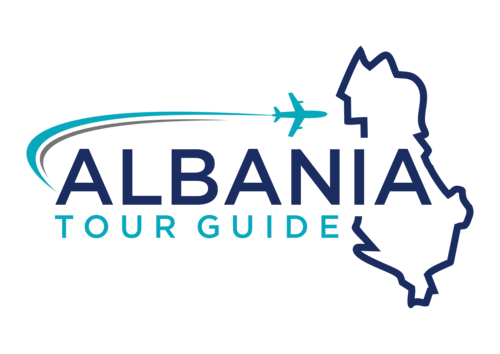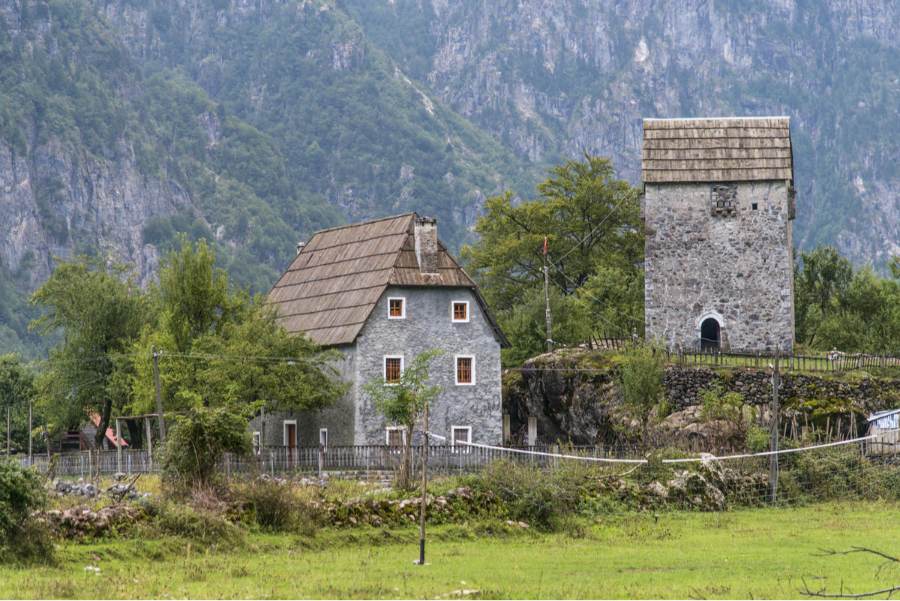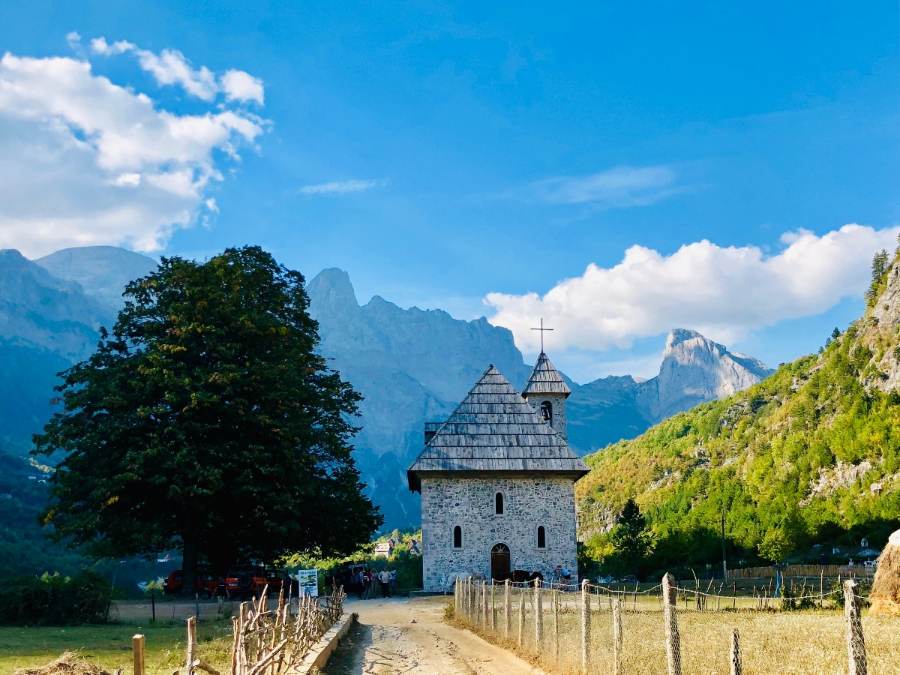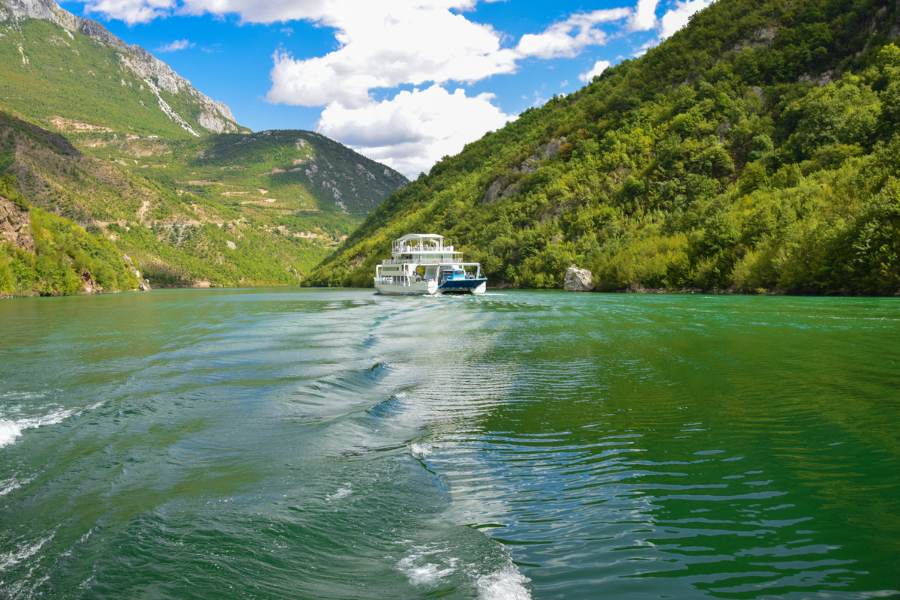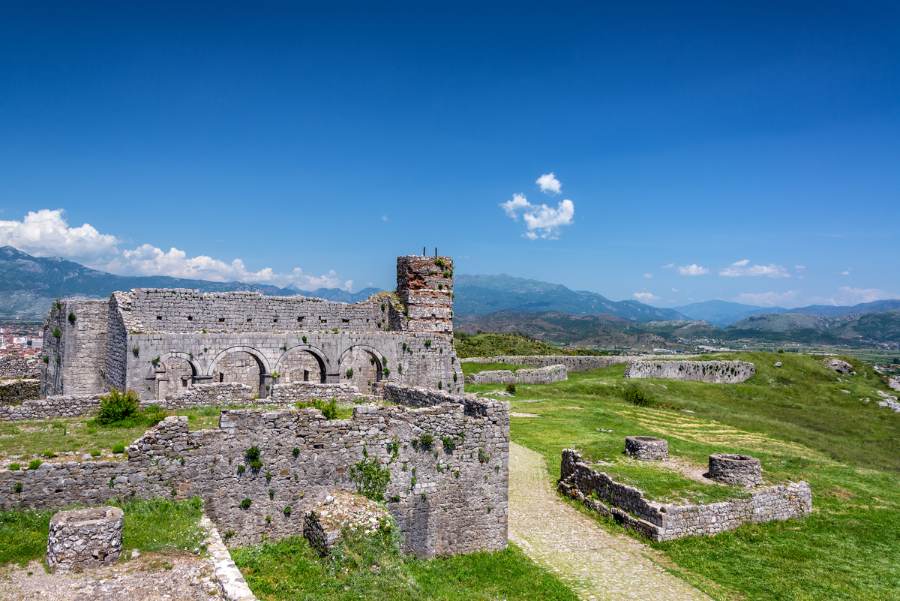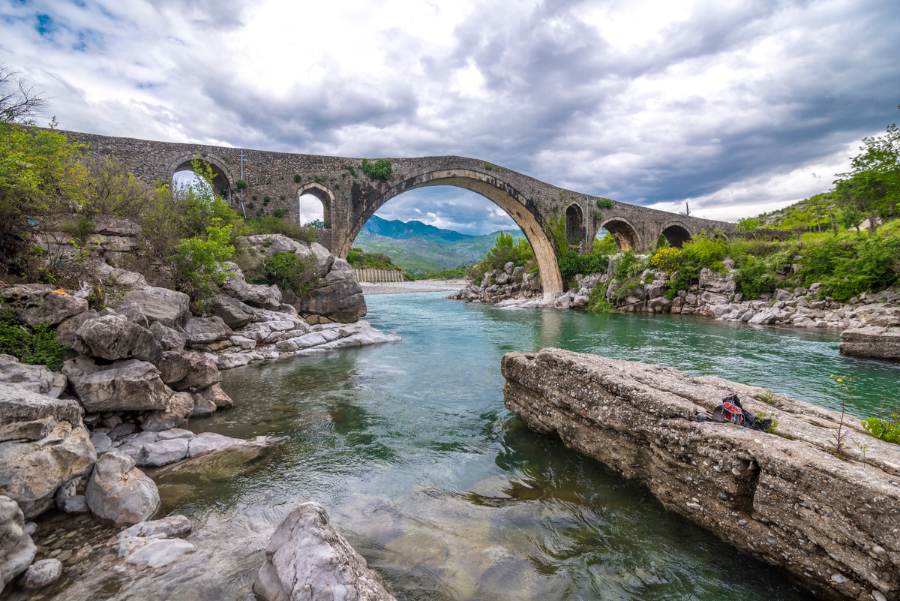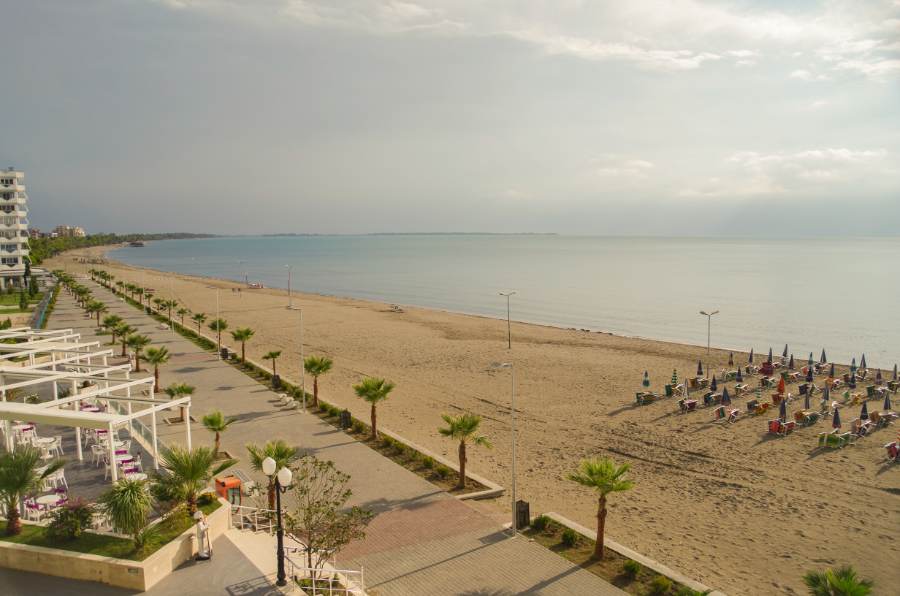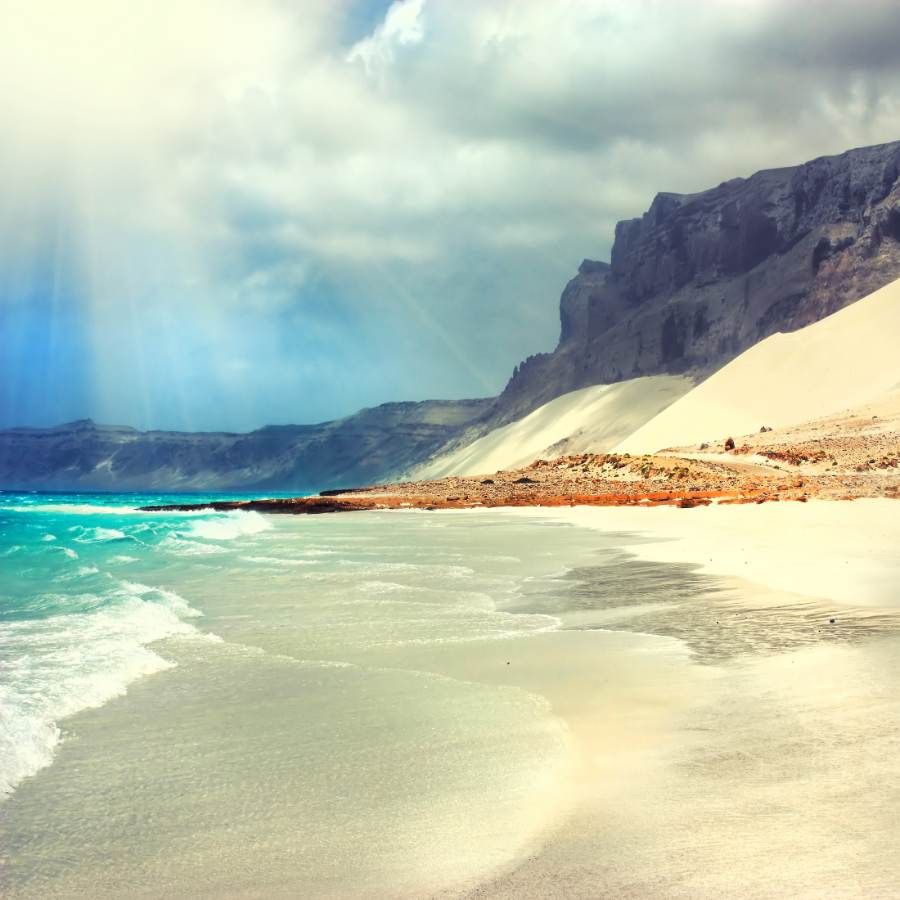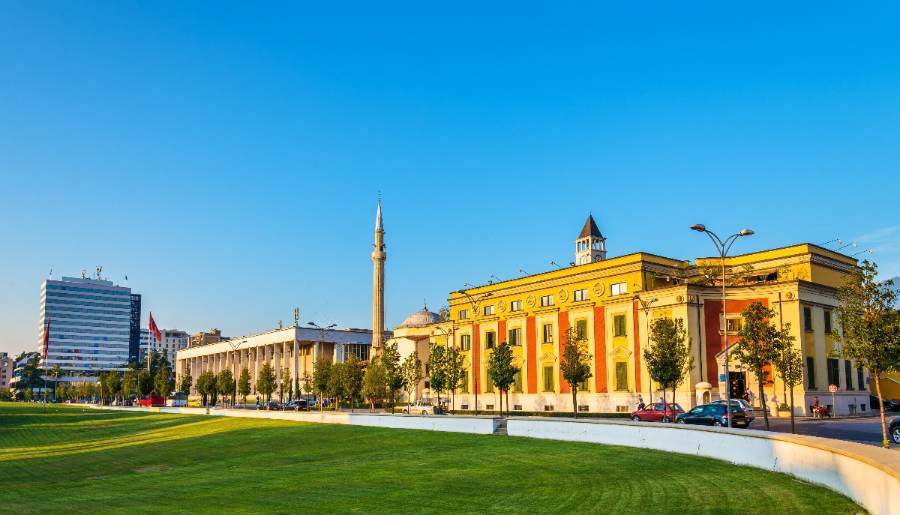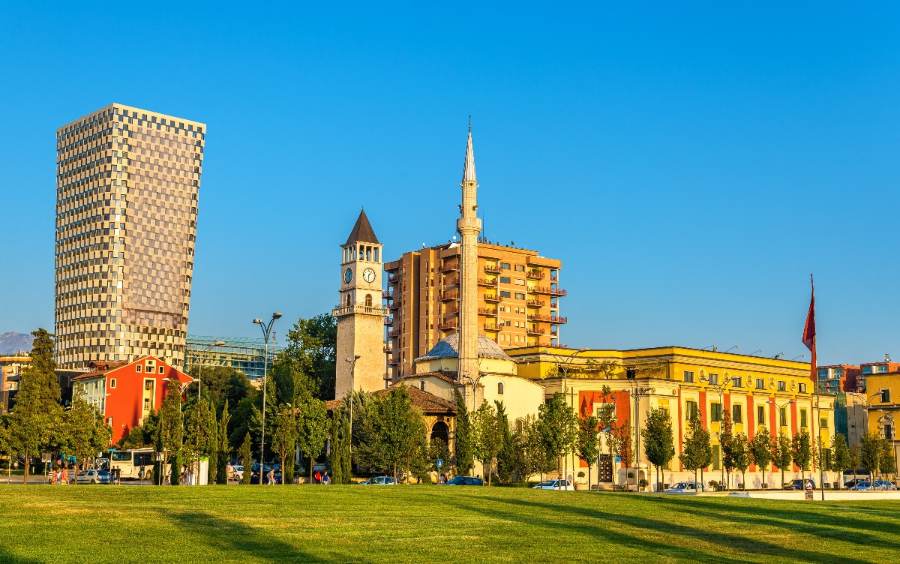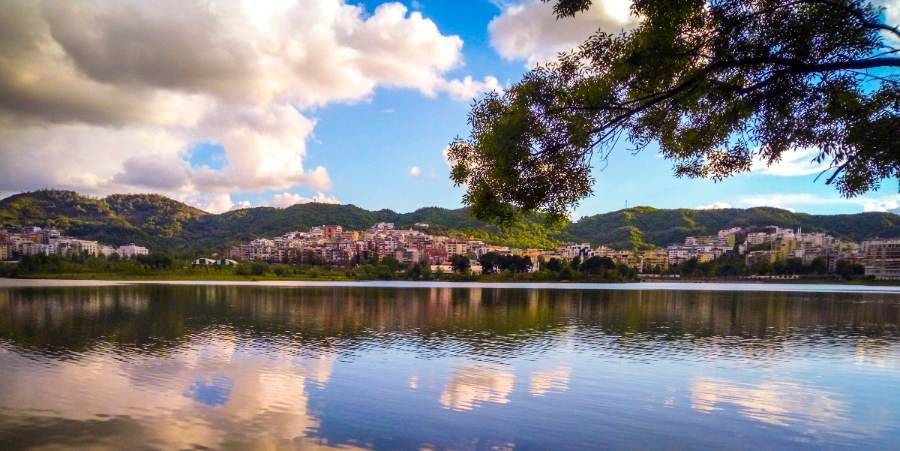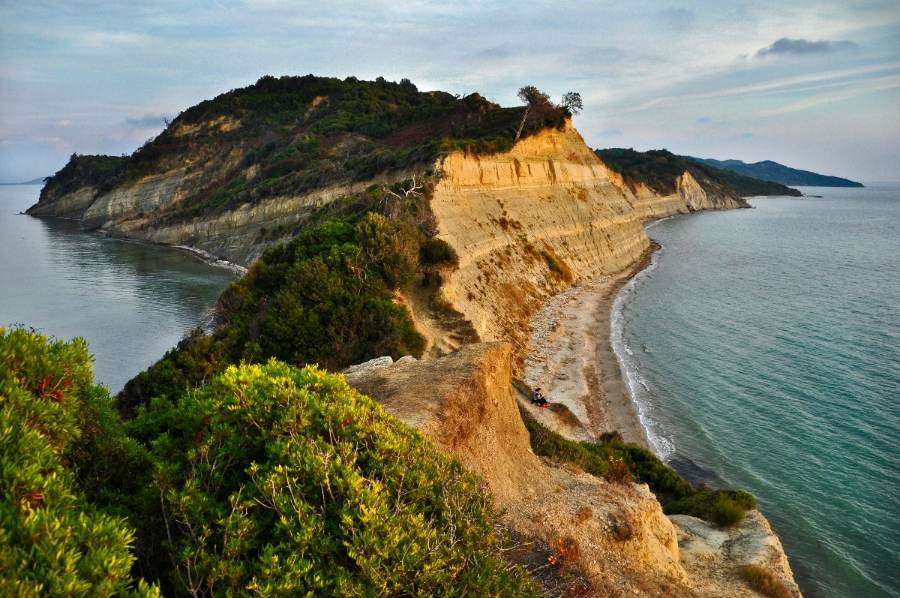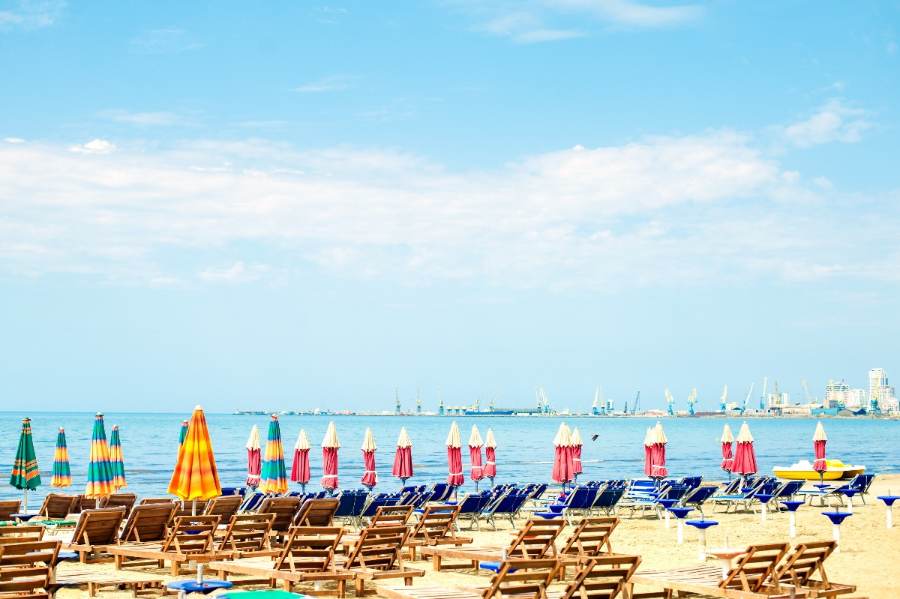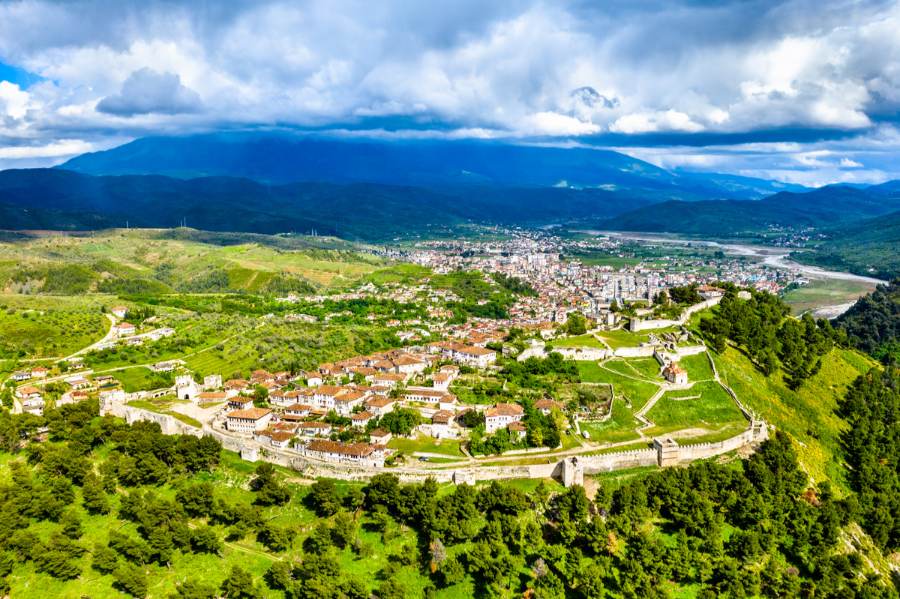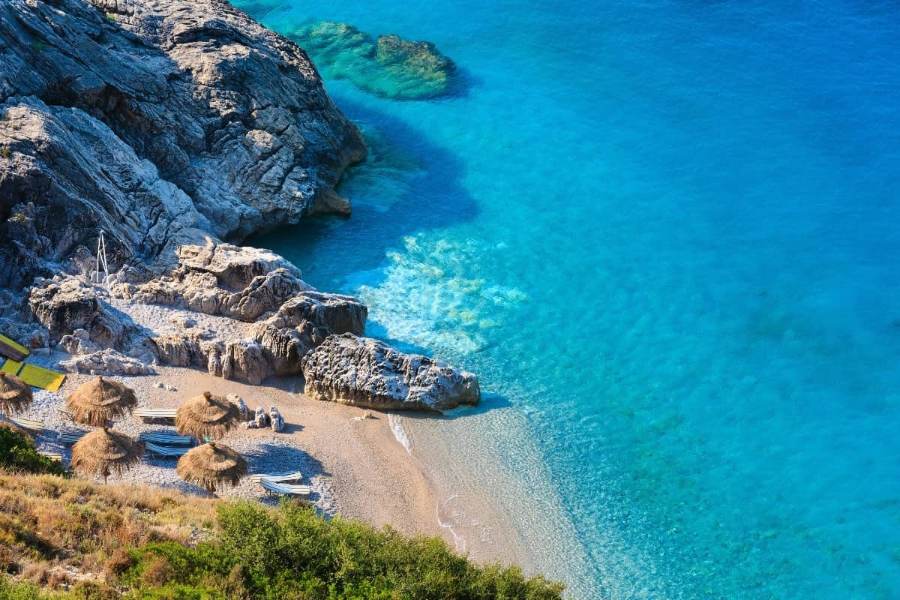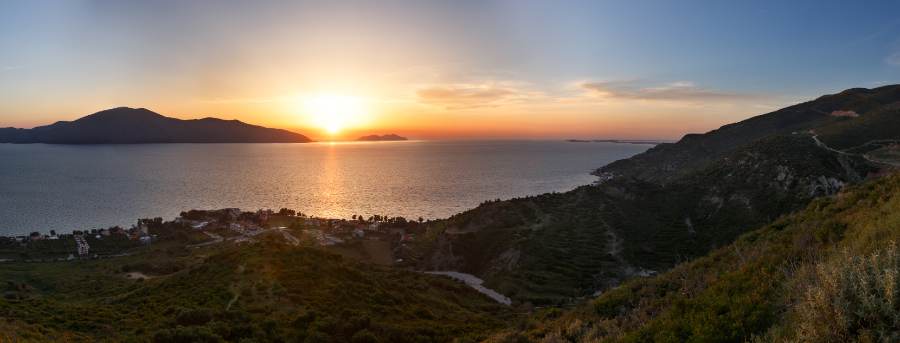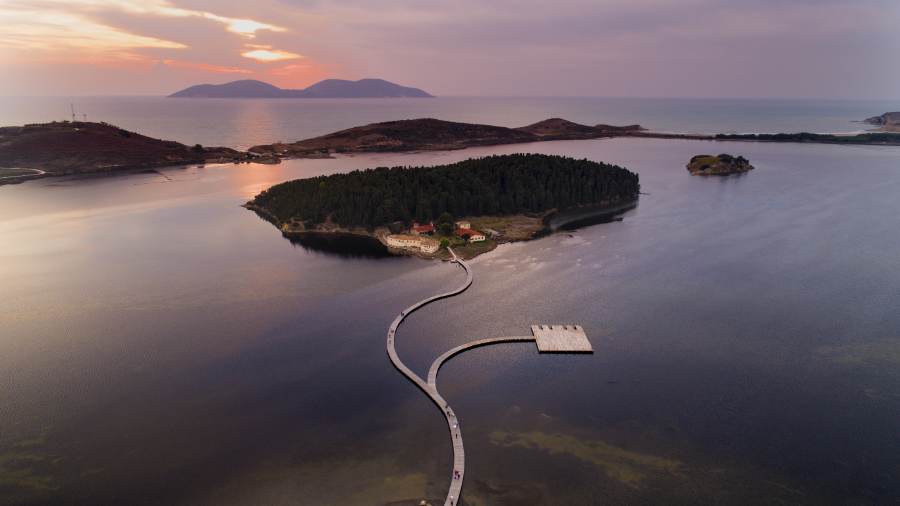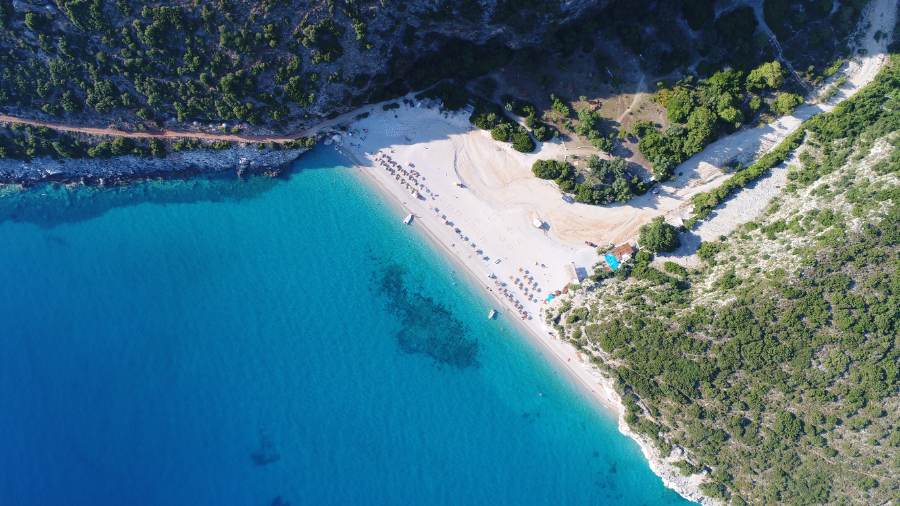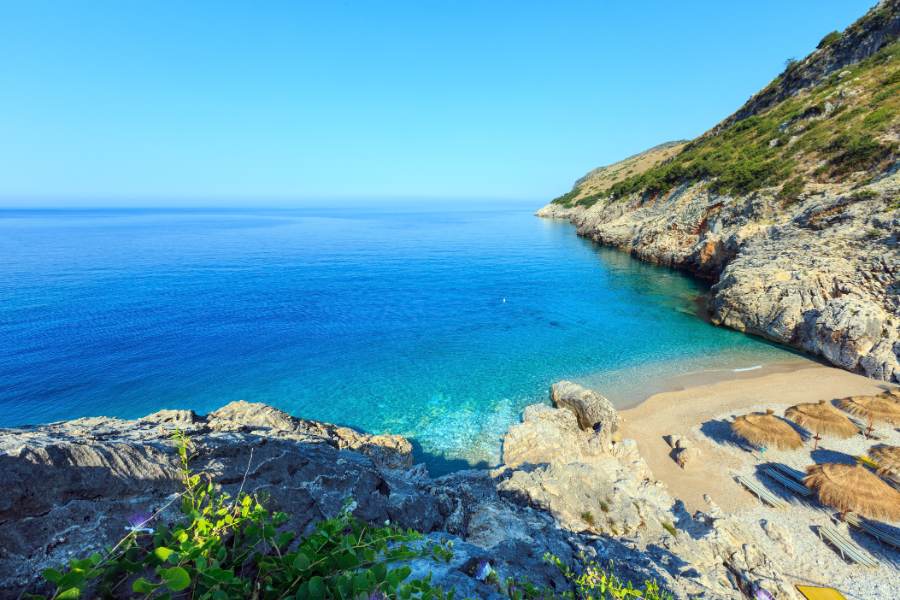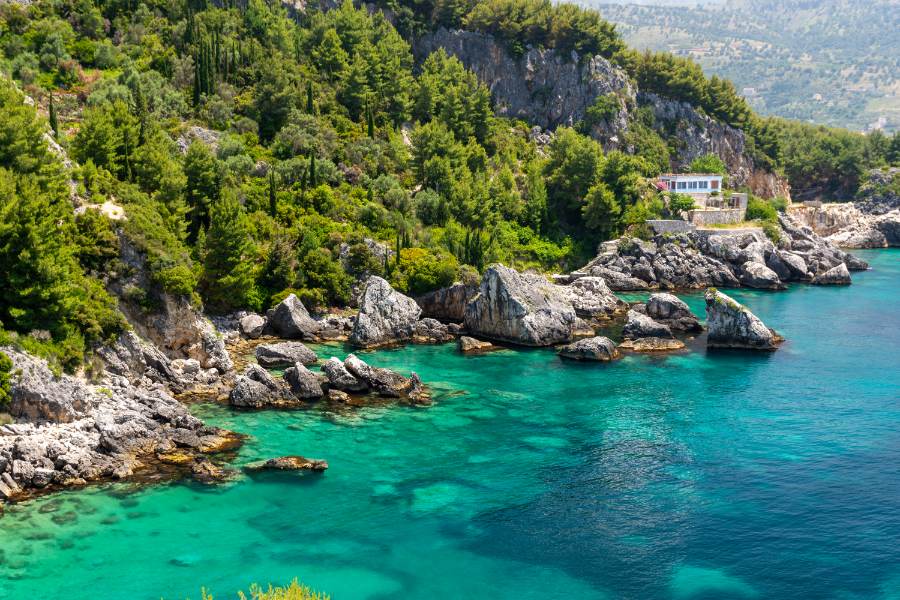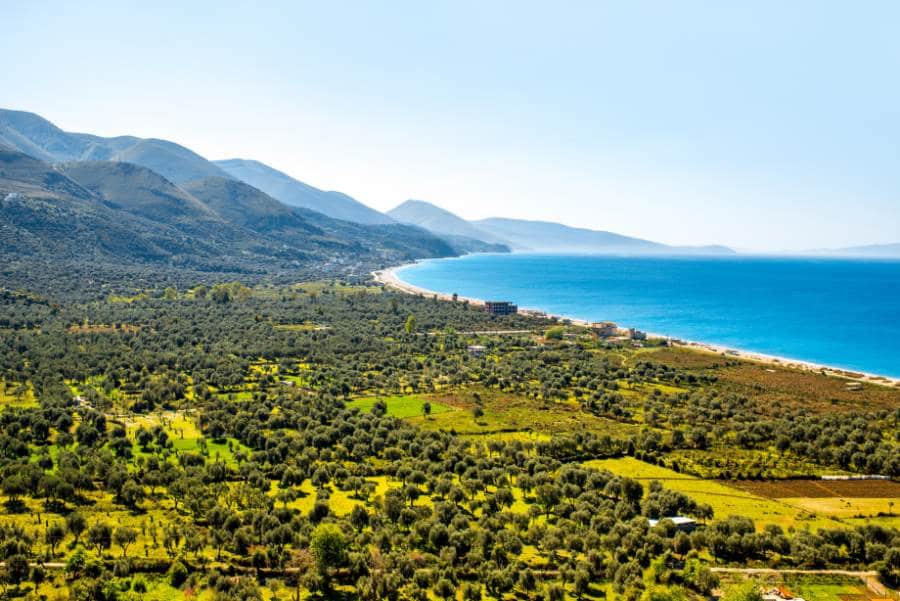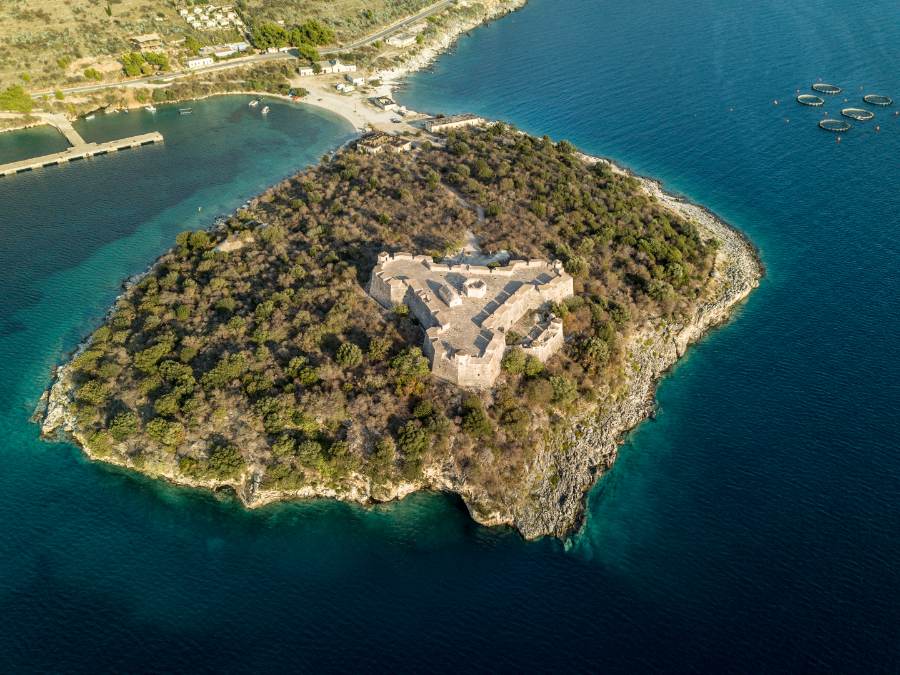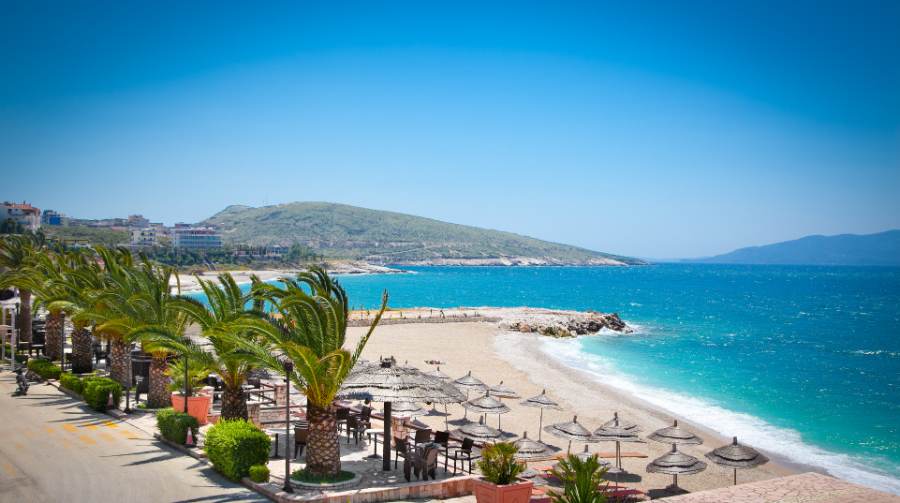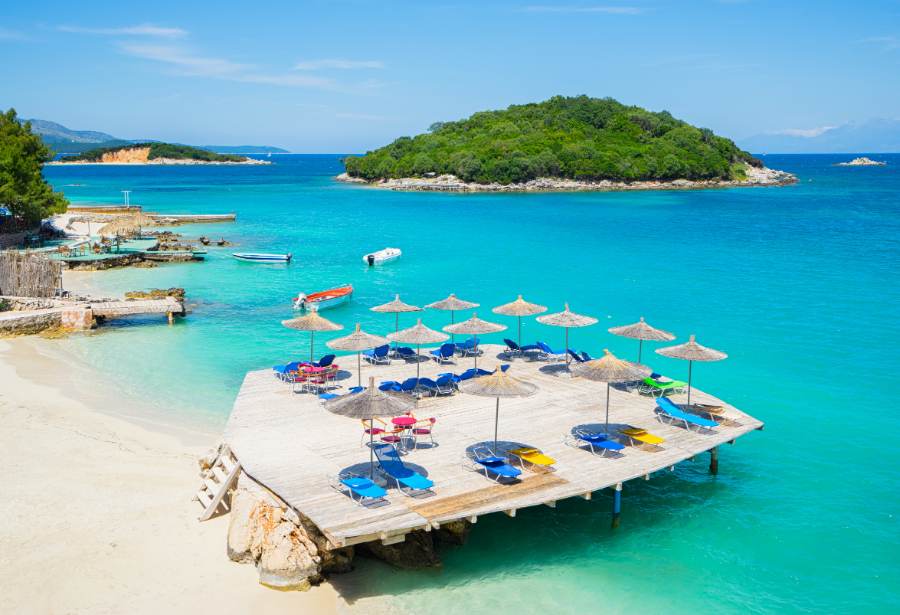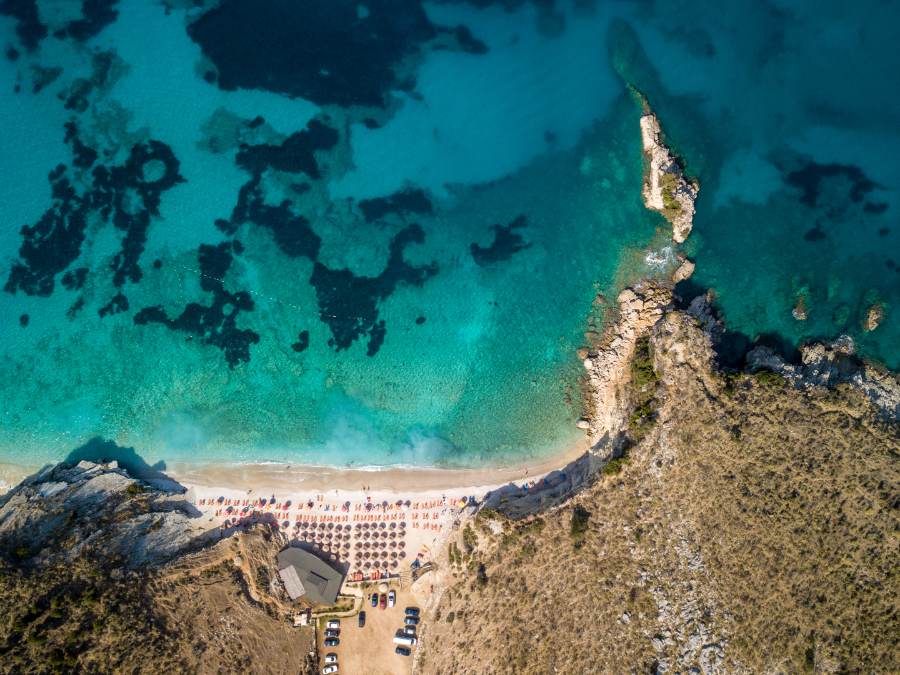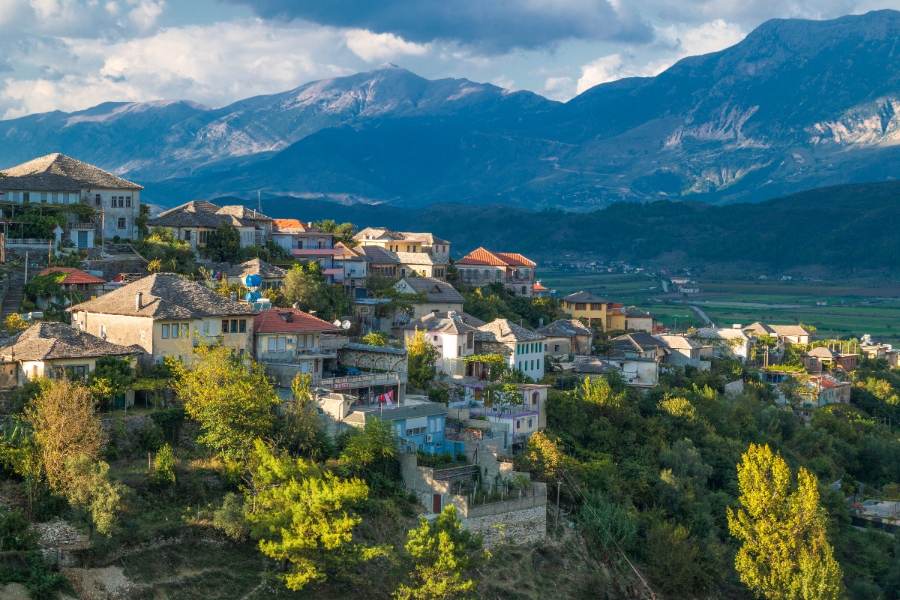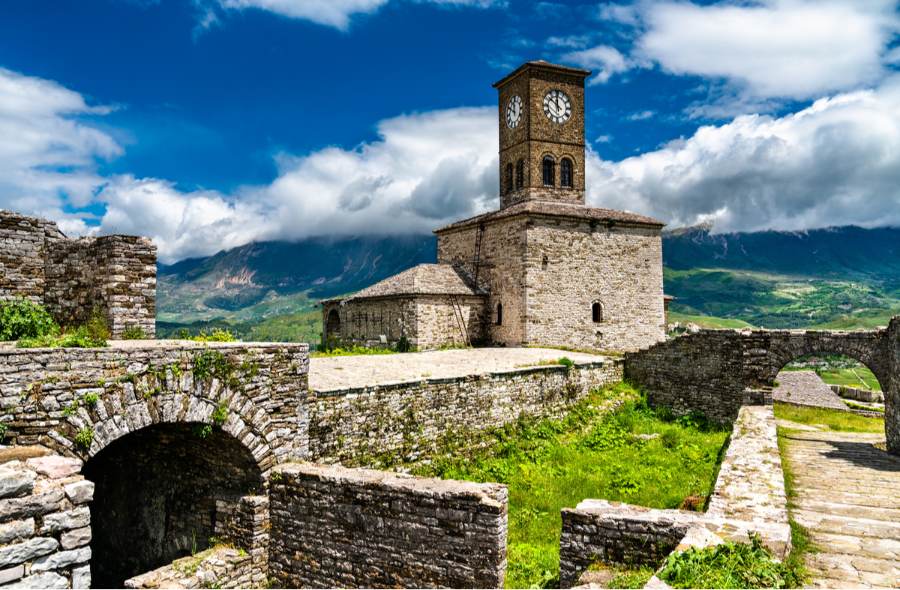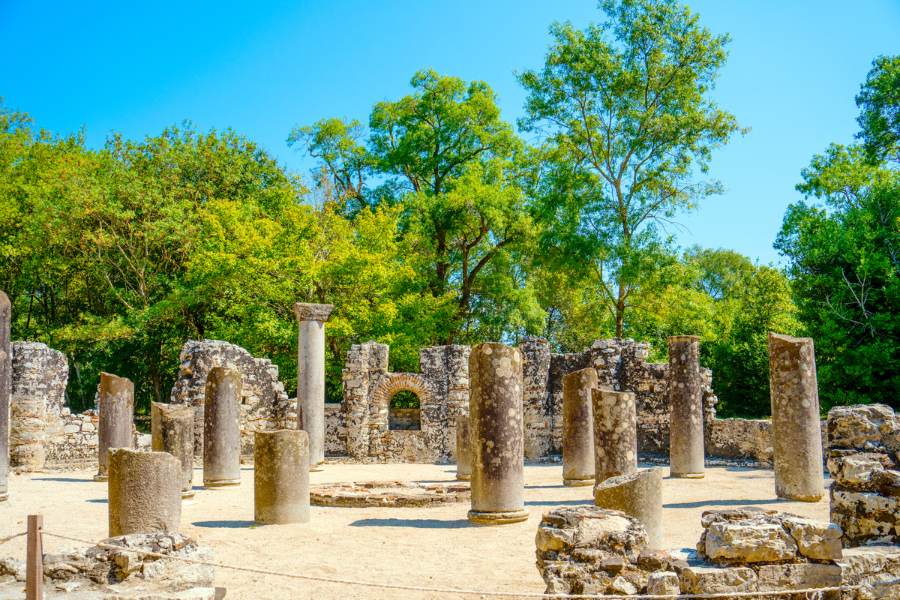
THE 84 BEST Things to Do in Albania
Here is a list of the top 84 things to do in Albania.
1. The Blue Eye of Theth
One of the most unique things to do in Albania is visiting the Blue Eye of Theth.
The Theth village is a remote mountain village, located in the Albanian Alps in the North of Albania. From the Theth village, you can hike for about 3 hours or take a four-wheel drive taxi to the trailhead of the hiking trail.
From the trailhead, you must hike for about 1 hour through mountains to reach the Blue Eye of Theth. The Blue Eye of Theth is a natural mountain pool.
I guarantee that the Blue Eye of Theth is one of the most beautiful natural places you have ever seen. The turquoise coloured pool is surrounded by mountain cliffs. The water is so clear that you can see every little rock on the bottom of the pool. And the natural mountain pool is filled by a little fountain in the corner.
If you dare, you can go for a swim in the Blue Eye of Theth. However, the mountain water is ice-cold all-year-round.
2. Hiking in the Albanian Alps
The Albanian Alps are an impressive mountain range in the North of Albania. If you are looking to go an active holiday and you enjoy hiking, then visiting the Albanian Alps is for you!
The most popular destinations within the Albanian Alps are the Theth village and the Valbone village. Most travellers make a 3 day tour starting and ending in Shkoder city.
If you are interested in taking a 3-day tour of the Albanian Alps. Then this is the classic itinerary:
On the first day, you travel by car from Shkoder city to the Theth village. In the Theth village, you can visit the beautiful Blue Eye of Theth, the Lock-in Tower and the Church of Theth.
Then the second day, you can hike accross the 1800 meter high Valbone Pass to the Valbone village. And on the final day, you can travel from Valbone with the Lake Koman Ferry back to Shkoder city.
3. The Grunas Waterfall
The Grunas Waterfall is one of the best things to do, if you plan on visiting the Theth village in the Albanian Alps.
From the Theth mountain village, you can hike for approximately 1 hour to get to the Grunas waterfall. The gorgeous natural waterfall is 30 meters high and surrounded by stunning nature.
4. Lock-in Tower in Theth
The Lock-in Tower is a historical tower located in the Theth village in the Albanian Alps.
One of the beauties of visiting the Theth village, is that it is a truly authentic village surrounded by the gorgeous peaks of the Albanian Alps. You can easily explore the village by foot. In Theth, you get to see how to the locals live their lives in this remote mountain area.
Within the village, one of the highlights is the Lock-in tower. The tower is a reminder of the time when the mountain people followed the traditional mountain laws, called “the Kanun of Leke Dukagjin”.
The Kanun is a set of old mountain laws, which the people in the Albanian Alps used to follow. Essentially, the Kanun sets out the rules about property, marriage, family, damages hospitality and blood feuds.
The Lock-in Tower played a central role in getting justice according to the Kanun of Leke Dukagjin. Those who commited a crime according to the Kanun, where imprisoned in the tower. But it was also a place of reconsiliation, where two families in a blood feud would come together to resolve their issues.
5. The Church of Theth
The Church of Theth is a classical sight in the Theth village. Whenever you see a picture of the Theth village online, you always immediately see the little Church of Theth, surrounded by the peaks of the Albanian Alps.
The Church of Theth is a historical church built in 1892 in the Theth village.
Throughout history, the inhabitants of Theth were Roman Catholics. Therefore, the Church of Theth was one of the first buildings in the Theth village.
In 1917, the priest of the church opened a language school in the church, to teach the children of Theth how to read and write in Albanian language. Which was something unique, because Albania had been ruled by the Turkish Ottoman empire for a long period of time.
During the communist regime, religion was forbidden. Therefore, during this period the church functioned as a health and pregnancy center. As a result most of the locals over 25 years old were born in the church. After the communism regime the damaged church was restored.
6. Valbone Pass
One of the most popular activities to do in the Albanian Alps is hiking across the Valbone Pass.
The Valbone Pass is the highest peak on the hiking trail between the Theth village and the Valbone village. The Valbone Pass is 1814 meters high. From the pass, you will have a stunning view accross the valleys of Theth and Valbone.
Travellers who aim to hike accross the Valbone Pass, start their journey in Shkoder city in the North of Albania. From Shkoder, you can travel by car to the remote mountain village of Theth, where the trail to the Valbone Pass starts.
Most travellers stay overnight in the Theth village, and start their day long hike accross the Valbone Pass early the next morning.
There is no road connection between Theth and Valbone, so if you would like to make a tour through the Albanian Alps, then hiking accross the Valbone Pass is your only option.
7. Valbone village
The Valbone village is a small mountain village in the Albanian Alps. Many hikers stay overnight in a guesthouse in Valbone, before starting their early morning hike across the Valbona Pass.
8. The Lake Koman Ferry
The Lake Koman Ferry should be on the top of your list of best things to do in Albania.
Lake Koman is a very beautiful lake that runs through the mountains in the North of Albania. In the Koman village, you can take the Lake Koman ferry boat, which takes you on a 3-hour journey accross the lake.
The ferry boat journey on Lake Koman is absolutely stunning. As the lake turns and twists through the mountains, every turn the ferry boat makes, reveals a beautiful new panorama.
In fact, the Lake Koman ferry journey is so beautiful, that Bradt Guides called it “one of the world’s best boat trips”.
Actually, the Lake Koman ferry was only intended as a means of transportation for the Albanian locals. However, the boat trip is so beautiful, that it started attracking backpackers and travellers from all over the world.
The Lake Koman ferry takes you from the Koman village to the Fierze village in about 3 hours. From Fierze, you can either travel onwards to the Valbone village in the Albanian Alps and plan a hike accross the Valbone Pass. Or you can take the same ferry boat back to Koman, if you only aim to take the ferry boat as a 1 day trip.
9. Shkoder City
Shkoder is a beautiful city in the North of Albania. The city is known for its artistic and cultural background. Because many Albanian artists settled in Shkoder throughout the years.
The center of the city is the beautiful Kole Idromeno street. This lovely pedestrian street has been designed in a Venetian style. There are beautiful terraces, cafes and restaurants all throughout the street.
Many tourists merely use Shkoder city as a starting point to travel to the Albanian Alps. However, Shkoder city itself has many highlights to offer, like Rozafa castle, the Marubi National Museum of Photography, the Venice Art Mask Factory and the Mesi Bridge. Scroll down for more information.
A very unique way to explore Shkoder is by bike. Within Albania, Shkoder city is known for its bikes. You can rent a bike to explore the city center. Or visit the nearby Shkoder lake on your bike.
10. Rozafa castle
Rozafa castle is a large castle on the top of a hill near Shkoder city. Although the castle itself is mostly in ruins, it offers a stunning panoramic view of the surrounding area.
From the castle, you can see the gigantic Lake of Shkoder, Shkoder city and the large rivers in the valley.
Another interesting highlight is the legend about the castle’s construction. According to the story, three brothers built the castle, but the walls would collapse overnight. And in order for the walls to remain standing a human sacrifice was needed.
Therefore, the brothers agreed that the wife, who would bring them lunch the next day, would be sacrificed. The two older brothers cheated and told their wives. As a result, the wife of the youngest brother Rozafa was sacrificed.
Rozafa agreed to be built into the castle’s walls, as long as her breast, hand and foot would be exposed so she could care for her infant son. There is a beautiful statue of Rozafa, that you can see on site.
11. The Mesi Bridge
The Mesi Bridge is a historical bridge about 5 kilometers to the northeast of Shkoder city. It is a gorgeous stone bridge layed with little cobblestones.
The Mesi bridge was built around 1770 by the local governor during the Ottoman empire. Nowadays, the bridge is not used for traffic, since a new bridge for cars was built just next to the Mesi Bridge. However, pedestrians can walk on the historical bridge to cross the river.
The Mesi bridge is a beautiful place to make a quick stop on your way to the Theth village. You can take some pretty pictures and have a little break before you continue your journey.
12. Marubi National Museum of Photography
In the city center of Shkoder, you can visit the Marubi National Museum of Photography. The museum displays a photo collection of 400.000 photographs that tell Albania’s history.
The collection shown in the Museum of Photography was taken by three generations of photographers. In 1850, Pietro Marubi, an Italian painter and photographer, emigrated from Italy to Shkoder for political reasons. Whilst in Shkoder, he founded a photo business called Foto Marubi.
He trained Kel Kodheli, who took over the family business after Pietro’s death and changed his name to Kel Marubi. And later Kel’s son, Gege Marubi followed in his footsteps.
The Marubi family photographed significant national events and daily life in Albania. There are portraits of tribal leaders, highland uprisings and influential persons, like Edith Durham.
13. Venice Art Mask Factory
The Venice Art Mask Factory is a factory and exhibition of Venetian Masks. The factory was started in 1997 by Edmond Angoni, who is originally from Albania, but spend a long period of time in Venice.
Back in Albania, Angoni began creating Venetian masks and turned it into a worldwide factory. The factory has eight shops in Venice and one in Las Vegas, and it sells masks in luxury shops in Dubai and Australia as well.
In the Venice Art Mask Factory, you can see a display of 1700 unique art masks. Each mask is produced by 12 or 13 professionals, who work on the molding, papier-mache, painting and decorations. The factory produces more than 30.000 masks per year.
It is very enjoyable to browse through the beautiful collection of masks. Each mask is a unique work of art. The masks vary in price point, so you might even find a unique souvenir to take home.
14. Site of Witness and Memory Museum
The Site of Witness and Memory Museum is a museum about the horrors of communism in Albania.
From 1944 until 1992, Albania was a communist country. For the vast majority of this period, the country was ruled by the communist dictator Enver Hoxha.
During this period, the country was isolated, similar to North Korea today. And any views or opinions that were not in line with that of the communist government, could lead to imprisonment or death.
The building of the Site of Witness and Memory museum was the headquarters of the Ministery of Internal Affairs.
Although that sounds like a regular govenment facility, it was actually an interrogation center and prison for people, who did not agree with the political views for the communists. And thousands of people died in this facility.
Inside the museum, you can see the pictures of the victims who died here and read the testimonies of the survivors. And you also get a unique look at the original prison cells and interrogation rooms.
15. Shengjin beach
Shengjin beach is a large coastal city in the North of Albania, close to Shkoder city.
When you visit Shengjin, you can expect numerous hotels, apartment complexes and bars. At this beach you have a choice of restaurants, varying from Albanian, to seafood and to Italian cuisine.
If you prefer quieter beach, you can drive onwards to the nearby Rana e Hedhun beach.
Shengjin Beach and Rana e Hedhun beach are close to the Albanian Alps in the North of Albania. So if you are planning to hike in the Albanian Alps and you still want to spend an afternoon on the beach, these beaches are a great. Because if you want to drive from the Albanian Alps to the Albanian Riviera this will take you several hours of driving time.
16. Rana e Hedhun beach
Rana e Hedhun is the best beach in the North of Albania. It is a hidden gem, so you can expect privacy at this beautiful beach.
Rana e Hedhun beach has a large sand dune, which runs from the mountain into the sea. Therefore, the beach is often called “Thrown sand”.
You can climb the massive sand dune and slide down towards the sea. Rana e Hedhun has a beautiful sandy coastline with little restaurants along the water.
Shengjin Beach and Rana e Hedhun beach are close to the Albanian Alps in the North of Albania. So if you are planning to hike in the Albanian Alps and you still want to spend an afternoon on the beach, these beaches are a great. Because if you want to drive from the Albanian Alps to the Albanian Riviera this will take you several hours of driving time.
17. Tirana
Tirana is the capital city of Albania. The two best things to do to explore the capital city is going on a walking tour through Tirana. Or if you are interested Albania’s communist history, then you can go on a themed communist walking tour.
A walking tour through Tirana, usually starts at Skanderbeg Square, which is the main square in the center of the city. At the square you can see landmarks, like the National history museum, the Tirana International Hotel, the Palace of Culture, the national opera house, the Et’hem Bey Mosque and the Clock Tower.
Skanderbeg square connects to the Boulevard of the Martyrs of the Nation, which is the main boulevard with all the government buildings. In this street, you can see landmarks like the Pyramid of Tirana, the National Art Gallery, the Presidential Office and the Grand Park of Tirana.
If you are interested in exploring Albania’s communist history, then Tirana is a great place to explore. In the city center, you can visit the famous Blloku area, which was closed off to the public during the communist period. In the Blloku area, you can also see the former residence of the dictator Enver Hoxha.
But there are many more sights in Tirana, that will tell you about Albania’s dark communist period. There is the Bunk’Art 1 Museum, which is a museum in a bunker about the communist period. And other highlights include the Pyramid of Tirana and the Museum of Secret Surveillance.
18. Skanderbeg Square
Skanderbeg Square is the main square in the center of Tirana. The square has a statue of the Skanderbeg, who is Albania’s national hero, who led the defence against the Ottoman-Turks. The National History Museum, the Et’hem Bej Mosque, the Palace of Culture, the National Bank and the Clock Tower are on Skanderbeg Square.
19. National History Museum
The National History Museum displays Albania’s archaeological treasures from Illyrian times until today. The collection includes statues from the Greek and Roman period, as well as a replica of Skanderbeg’s sword. There is also a gallery about the prosecutions during the communist regime.
20. Et’hem Bej Mosque
The Et’hem Bej Mosque is a little mosque on Skanderbeg Square in the center of Tirana. The Mosque was constructed between 1790 – 1820, but closed during the communist period. In 1991, the mosque was re-opened without government permission and 10.000 people attended the reopening. The mosque has beautiful frescoes of trees, waterfalls and bridges.
21. Clock Tower
The Clock Tower is a 35-meter-high tower next to Skanderbeg Square. The tower was built in 1822 during the Ottoman empire. You can climb the tower and have a fantastic view of Skanderbeg Square and the city center.
22. Bunk Art 1 Museum
If you only have time to visit one museum in Albania, then you should choose to visit the Bunk’Art 1 Museum. Because Bunk’Art 1 is by far the most innovative and impressive museum in Albania.
Simply said, Bunk’Art 1 is a museum about Albania’s history INSIDE A COMMUNIST BUNKER.
To give you a brief history of Albania. Albania was ruled by the communist dictator Enver Hoxha from 1944 to 1985. Throughout this period, Albania was isolated from the rest of the world, similar to North Korea today.
Enver Hoxha was convinced that a foreign attack on Albania was imminent, therefore, he constructed 750.000 bunkers all over Albania. And he built a very large, multiple room bunker for himself and his government in Tirana. The foreign (nuclear) attack never took place, but the bunkers remain visible all over the country.
The large bunker, that Enver Hoxha constructed for himself, was recently converted into a museum about Albania’s communist history.
Entering Bunk’Art 1 is an experience. You walk through a massive concrete door into a sanitation room, intended to wash off nuclear waste. Inside, you can hear the dictotor speak, see video footage of the marches in the city center and see the dictators room.
But you also get to see the darker side of the communist regime. As the museum explains you about the imprisonment, deaths and the nuclear tests. Moreover, you also get to see the fencing that was constructed around the country to keep the Albanian people inside.
In short, the Bunk’Art 1 museum is very impressive, although a little creepy…
23. Dajti Ekspres Cable Car
One of my favorite places to recommend is the Dajti Ekspres Cable Car.
At a 20-minute drive from Tirana’s city center, you can get on the Dajti Ekspres. The Dajti Ekspres is an Austrian built cable car. The cable car takes you from the lower station to a height of 1613 meters in a 15-minute journey.
The cable car journey is absolutely breathtaking. From the cable car, you look down on farm houses, treetops and mountain cliffs. And the higher up you fly, you get to look down on Tirana’s city center from above.
Once you arrive at the upper balcony, there is a variety of entertainment available.
One of the highlights is having lunch in the Ballkoni restaurant, which is a cabin style restaurant on the top of the cliff. And since the restaurant has floor-to-ceiling windows, you get to see Tirana’s city center, Durres beach and the Adriatic Sea in the distance.
Apart from the restaurant, you can go horse riding, play mini-golf, shoot at targets, have a drink in the rotating bar and hike to the nearest mountain top.
The Dajti Ekspres Cable Car is by far one of the most enjoyable day trips you can make from Tirana. And it is also great in combination with the nearby Bunk’Art 1 Museum.
24. The New Bazaar Market in Tirana
If you are staying in Tirana, then I absolutely recommend visiting the New Bazaar Market.
The New Bazaar Market or “Pazari i Ri” in Albanian is a local food market in Tirana’s city center. On the market, you can buy local products, like fruits, honey, handicrafts and homemade food.
The great thing about visiting this market place, is that you get to see the real Albanian culture. You can taste some of the local products, like the mountain honey. And you can mingle with the locals.
But the best part is the variety of lovely restaurants and cafes surrounding the market place. Overall, the New Bazaar Market has a great atmosphere and it is a definate must if you are a foodie.
25. House of Leaves: Museum of Secret Surveillance
The House of Leaves is one of the newest museums in Tirana’s city center. Inside the museum, you get a unique insight into the work of the secret service during Albania’s communist regime.
The museum of secret surveillance is based on a very discrete villa in the center of Tirana. This villa was the former headquarters of the Sigurimi, which was the secret service during the communist period.
Recently, the former HQ was converted into a museum about the secret surveillance. Inside, you get to see the bugs, monitoring equipment and wiretapping telephones that were used by the regime.
As you can imagine, any views or opinions that were not in line with the communist government’s guidelines, could lead to imprisonment or even death.
Albania as a country is still dealing with its relatively recent communist history, and this museum is one of its ways to recognize the cruelties of the former communist regime.
26. The Pyramid of Tirana
The Pyramid of Tirana is a landmark in Albania’s capital city.
The pyramid is a building that stands out in Tirana. The massive concrete pyramid was originally built as a museum about Albania’s former dictator Enver Hoxha. It was designed by the dictator’s daughter and her husband after the dictator’s death.
However, in 1992, when the communism ended in Albania, the pyramid stopped being a museum about the former dictator. After that, the pyramid was used for a variety of causes. It was a convention center, a night club, a television station and a base for NATO during the Kosovo war.
There were plans to demolish the pyramid, however, the majority of Tirana’s citizens were against the demolition. Because the pyramid is part of the Albania’s history, however, dark this history may be.
Many plans for refurbishment or repurposing were presented. The most recent one states that the pyramid will be converted into an IT center for youth, with a focus on computer programming, robotics and startups.
Whilst the pyramid of Tirana awaits its next purpose, the building has fallen into dispear and it has been covered with graffiti. The current state of the pyramid shows that Albania is trying to deal with its cruel communism history, one step at the time.
27. Boulevard of the Martyrs of the Nation
The “Boulevard of the Martyrs of the Nation” is a wide street with many Parliament buildings. Along the street, you can see the Pyramid of Tirana, the National Archaeological Museum, the Presidential Palace and the National Art Gallery. The boulevard was designed by the Italian architect Gherardo Bosio.
28. National Arts Gallery
The National Arts Gallery shows Albanian paintings from the early 19th century until today. The Albanian Art is unique, because during the communist regime, the government censured the art. Artists needed to create art, that idealised the communist dictator Enver Hoxha. Moreover, some of the “inappropriate” art, is also shown, for which the artists went to prison.
29. Grand Park of Tirana
The Grand Park of Tirana is the central park in the city. The park has a large lake with beautiful paths and running tracks by the lake front. There are numerous playgrounds for children. And lovely coffee houses with a lake view.
30. Blloku Area
The Blloku Area is the coolest and most vibrant area in Tirana. In the past, the area was used by the communist government and closed off to the general public. Nowadays, it is an area with many restaurants, clubs and coffee houses. If you want to go out at night, you will enjoy Blloku.
31. Enver Hoxha’s Former Residence
The three-story villa of the former communist dictator Enver Hoxha is in the middle of the Blloku Area. The villa is left just as when the dictator died in 1985. In the past the whole Blloku area was sealed off from the public and only accessible for party elite and their families. Enver Hoxha’s residence is visible from the street, but closed off for the public.
32. The Cape of Rodon
The Cape of Rodon is the most beautiful place on the coastline in the vicinity of Tirana.
Basically, the cape of Rodon is a rocky peninsula, that points into the Adriatic sea. It is a stunning place for sightseeing, because the cape is covered in lush green nature, which is beautiful in contrast with the wild waves of the sea.
The Cape of Rodon is a true hidden gem and an untouched natural miracle. Visit when the sun goes down, for gorgeous pictures of the sunset over the cape.
33. The Bay of Lalzi
If you are looking for a beautiful beach close to Tirana, then the Bay of Lalzi is perfect for you.
Lalzit beach is a quiet and uncrowded beach. The beach is surrounded by pine trees and mountains that run into the sea.
The beauty of the bay of Lalzit is that it is so natural, there are only two little cabin restaurants at the beach.
34. Preza castle
The Castle of Preza is a hidden gem, and therefore, you won’t offen see it on lists of things to do in Albania.
About 45 minutes from the capital city Tirana, you can visit the small Preza village. When you enter the village, you will drive up a narrow turning and twisting road, which leads to the hilltop castle.
The castle of Preza itself is mostly ruins. You can see the walls and the towers that surround the hill. But the true attraction here is the amazing panoramic view.
The view at Preza castle is absolutely stunning. From the castle, you can see Tirana city, Kruja city, the surrounding hill landscape, a gorgeous wild Lake and Durres beach. You can enter one of the remaining towers, sit down and stare into the distance for hours.
And the best part about Preza is that very few tourists know about this destination. So you will likely have this stunning place to yourself or share it with a few of the locals.
35. Petrela castle
Petrela castle is a hilltop fortress in the Petrela village, which is located about 45 minutes from Tirana.
If you are staying in Tirana city and you would like to go on a day trip, then the Petrela castle is a great choice.
Compared to Tirana city, the Petrela village has a very romantic and idylic athmosphere. When you enter the road to the village, you drive through nature and olive groves. Along the road, there are little mom and pop owned hotels and restaurants. The road turns and twists through the village and leads to the Petrela hilltop castle.
The castle of Petrela is mostly famous for its role in the defence against the Ottoman invansion. Skanderbeg was an Albanian military commander, who defended the Albanian tribes against the Ottoman invasion.
Skanderbeg was based in the nearby Kruje castle. And his sister Mamica was based in Petrela castle. The different hilltop castles could signal each other, should the enemy be approaching.
The castle of Petrela was built on a very large rock on the top of the hill. Within the castle walls, there is a little coffee house with a bridge, from where you have the most amazing panoramic view.
36. Pellumbas cave
If you are staying in Tirana and you would like to go for a hike in nature, then the Pellumbas Cave is a great destination for you.
At about a 45-minute drive from Tirana city, you can visit the Pellumbas village. From the village, you can undertake a 45 minute hike through nature to reach the Pellumbas cave.
The hiking trail leads through the mountains and from the trail, you will have stunning views of the valley below. Hiking to the Pellumbas cave is an adventure, but it does not require you to be an experienced hiker.
At the end of the trail, you can enter the large Pellumbas Cave, which is also called “the Black Cave”. Be sure to rent a light at the trailhead, so that you can explore the inside of the cave too.
37. Durres beach
The beach of Durres is one of the most famous beaches in the North of Albania. Durres is very popular, because it is only a 45-minute drive from the capital city Tirana.
At this beach, you can expect full facilities. Along the coast, you will find numerous hotels, restaurants, apartment buildings and bars.
If you enjoy a vibrant atmosphere and you like going to a party on the beach, then you will enjoy visiting Durres.
38. The Roman Amphitheater of Durres
Durres is mostly known as a large coastal city, which is conveniently located only 45 minutes from Tirana. However, apart from beaches, the city also has an ancient Roman Amphitheater.
The Roman Amphitheater of Durres is a UNESCO World Heritage Site. It was built by the Romans after the 2nd century B.C., when the Roman empire was led by emperor Trajan.
In its glory days, the Amphitheatre was able to seat between 15000 – 20000 spectators in its arena. The arena was used to host gladiator spectacles and events.
The Roman amphitheater was rediscovered in 1966. These days the theater is located in the middle of the city center of Durres.
39. The Archaeological Museum in Durres
If you enjoy exploring archaeological treasures, then you will be very impressed with the Archaeological Museum of Durres.
The archaeological museum of Durres is ultra-modern, well lit and labelled professionally. The museum has a large collection of historical artefacts from the prehistoric period, the Hellenistic period and the Roman period.
You can see bronze axes and hammer heads from the Prehistoric period. There are ceramic objects from the Hellenistic period. And coins from the Roman period.
Moreover, there is also a collection of objects found on the bottom of the sea near Durres, like ship anchors.
The objects found under the ground and at the bottom of the sea near Durres city, show that this was an important city many centuries ago.
40. Castle of Kruja
Kruja is one of the classic day trip destinations for people who are staying in Tirana. At Kruje, you can visit the impressive hilltop castle, which has the most amazing view of the entire valley. It is a popular place to visit, because it is only 45 minutes from Tirana.
From the castle, you have a panoramic view of Tirana city, the Kruje village, Durres beach, the Adriatic Sea and the valley.
The Castle of Kruje is mostly known, because it was the headquarter of Skanderbeg. Skanderbeg is a national hero for the Albanian people. Because he was the military commander, who defended the Albanian people against the Turkish Ottoman invasion. More importantly, he brought the Albanian tribes together, in their fight against the Ottoman empire.
Apart from the impressive views, you can also visit the Skanderbeg museum and the Ethnographic museum inside the castle. And there is a lovely traditional bazaar market with handicraft items and souvenirs from Albania.
41. The Skanderbeg Museum
The Skanderbeg Museum is one of the most visited & most important museums in Albania. It is named after Skanderbeg, who is Albania’s national hero. Skanderbeg was a warrior and battle commander. He reunited the different Albanian families and tribes. And he created an army that fought against the Ottoman Turks for 25 years.
In the museum, you can experience the story of Skanderbeg’s life and military battles in chronological order. You get to know the story of Albania’s most celebrated national hero!
42. Ethnographic Museum of Kruja
The Ethnographic Museum of Kruja is a traditional home, where you can get a unique, insight into the traditional Albanian household customs.
The house was originally build in the 19th century by the affluent Toptani family. Inside the museum, you will see how self-sufficient the family was.
The family produced its own food, honey, leather, weapons and olive oil. It even has a mini hammam and a little watermill. The house’s wall displays beautiful fresco paintings.
43. Old Bazaar Market
The Old Bazaar is one of the oldest Ottoman-style markets in Albania. The market place was build over 400 years ago and it was restored recently in 2015.
At the bazaar, you can buy souvenirs and traditional handicraft items from Albania. Popular products in the market are traditional Albanian clothing, rugs, copper pots, silver jewelry and embroidered tablecloths.
It is a lovely market to stroll around or you can enjoy a coffee at one of the cafe’s along the market.
44. The Cave of Sarisalltik
If you plan on visiting Kruje, then it is worth driving up the hill to Mount Sarisalltik, which is very close.
The Mountain and Cave of Sarisalltik are located at a height of 1176 meters, and therefore, this location has a stunning view. But for the Albanians, it is not only the view that attracks them to this location.
For the Albanian people, the cave of Sarisalltik is also a religious location. Pilgrims hike up to the cave, because the journey has a sacred meaning for them.
Sarisalltik was a religious leader from the Bektashi religion. Inside the cave of Sarisalltik, you can visit the fountain of holy water, the first Albanian mosque and the grave of Sarisalltik.
Even if you are not a Bektashi believer, you can still appreciate this beautiful location and have a coffee at the cafe whilst enjoying the view.
45. Fortress of Bashtove
The Fortress of Bashtove is a hidden gem, that very few tourists know about. Bashtove is a massive fortress, which has a 60 x 90 meter rectangular shape.
The castle of Bashtova is located about 30 kilometers to the south of Durres city. Much of the castle’s original walls and towers are in tact.
You will be amazed by the sheer size of the castle. Not only is it 60 meters wide and 90 meters long. The castle also has 9 meter high walls. And the walls of the castle are 1 meter wide. You can climb the staircase and walk on the top of the wall for a better view of the castle and its surroundings.
Currently, the Fortress of Bashtova is on the tentative list for review as a UNESCO heritage site. According to the Turkish traveller Evliya Celebi, the castle was built by the Venetians and later conquered by the Turkish Ottoman empire.
Bashtova is a great place to make a stopover on your way to the South of Albania. Do not expect any facilities, like restaurants and shops around the castle, because this castle has not been developed (yet) as a touristic site. But perhaps that is exactly the beauty of it!
46. Berat city
Berat city is without a doubt one of the most beautiful cities in Albania. As a result, the historical city center of Berat is popular amongst tourists and Albanian locals alike.
Berat’s historical city center is a UNESCO World Heritage Site. The main attraction in Berat are the beautiful stone houses, that were built on the hillside. The houses are organized in two quarters, the Mangalem quarter and the Gorica quarter, on either side of the river.
If you stand at the bottom of the hill, it looks like all the little, white houses are stacked on top of each other. And all their windows look down on the valley. Therefore, Berat is also known as “the city of a thousand windows”.
On the top of the hill, above the historical houses, you can visit the Berat castle. Which has a gorgeous panoramic view and you can see the city center from above.
If you only have time to visit one historical city in Albania, than you should absolutely choose Berat.
47. Berat Castle
The Castle of Berat (or in Albanian “Kala” Castle) is a large fortress on the top of the hill in the city Berat.
The fortress was built in the 4th century B.C. And inside the castle, there is a village like neighboorhood. Most interestingly, there are still people living side the castle today.
The Castle of Berat is well worth a visit, because it has stunning views of the surrounding area. From the castle, you can see the impressive Tomorr mountain, the river and the old town of Berat.
48. The Mangalem & Gorica Quarters
The Mangalem & Gorica Quarters are the old neighbourhoods that make up the old town of Berat city.
These are the traditional neighbourhoods build on the side of the hill, that Berat city is famous for. If you stand in the valley, you will see hundreds of little white Ottoman-style houses build on the side of the hill.
From the bottom of the hill, it looks like the little houses are stacked on top of each other. Therefore, Berat is called “the city of a thousand windows”.
The old neighbourhoods are very well preserved. The streets are layed with beautiful cobblestones. And many of the old houses are still in use, or they have been converted into hotels, restaurants or shops. Overall, Berat is a very romantic city with an Italian feel and a Meditereanean atmosphere.
49. Onufri museum
The Museum of Iconography is a museum with religious painting from several Albanian monasteries. The museum is located within the castle walls of the Berat Castle.
The museum is set in the largest church on the premises, called “the Church of the Dormition of St. Mary”. The museum is named “Onufri” after the Albanian fresco and icon-painter.
50. Ethnographic Museum in Berat
The Ethnographic Museum in Berat gives you a unique insight into the Albanian lifestyle.
The Ethnographic Museum is located in the old town of Berat, just below the hilltop Berat castle. The museum is essentially an 18th century Ottoman house, that has been converted into a museum.
On the ground floor, you can see a traditional medieval bazaar with embroidery, woodcarving and metalworking shops. On the second floor, you can visit a traditional house with a guest room, a kitchen and a work room.
51. Apollonia Archaeological Park
Apollonia is an archaeological park in the center of Albania. At the park, you can see the ruins of an ancient city.
In its glory days, Apollonia used to be an ancient Greek city and a Roman city. The city of Apollonia was founded by Greek colonists from Corfu and Corinth in 588 BC. However, it was during the Roman period that the city of Apollonia really flourished.
In the 4th century AD, Apollonia was an important economic city and trade center. The city was known for its famous school of philosophy. Cicero, a famous Roman public speaker, called Apollonia “a great and important city”. And the city was also one of the most important gateways to the Via Egnatia, which was a Roman trade route through the Balkans.
The ruins of Apollonia were re-discovered in the beginning of the 19th century. The park is set of a hilly plateau and it is surrounded by calming nature.
The Apollonia archaeological park is located about 20 minutes from the Albanian city Fier. If you are driving from Tirana city to Vlore beach or the Albanian Riviera, you can visit Apollonia along your route to the South of Albania.
52. Ardenica Monastery
The Ardenica Monastery is a small monastery, located on a hilltop between the Albanian towns Lushnje en Fier.
Inside the monastery, you can see beautiful religious paintings. There are icons of saints, sinners, dragons and angels. Furthermore, there is a very beautiful goldon pulpit, from where preachers could deliver their speaches. And there are lovely frescoes, which were painted by the Zografi brothers.
The Ardenica monastery was build in 1282, by the emperor Andronikos II Palaiologos, when Albania was a part of the Byzantine empire. And one of the most interesting events that took place in the monastery is the wedding of Albania’s national hero Skanderbeg to his wife Donika.
In the 17th and 18th century, the monastery was well-known for its large library, which brought many priests from all over the world to the monastery to do their research. Moreover, the monastery also functioned as an Albanian language school.
Apart from its religious history, the monastery is also worth visiting for its amazing views of the Adriatic Sea, Mount Tomorr and Mount Dajti.
53. The Albanian Riviera
One of the main reasons why tourists visit Albania, is the Albanian Riviera.
In essence, the Albanian Riviera is a strip of coastline with gorgeous beaches in the South of Albania. The Albanian riviera is known for its isolated bays, perfect white beaches and turquoise sea water.
Whereas the French riviera, the Spanish beaches and the Italian coastline are very crowded in the summer season. The Albanian Riviera is still quiet and relatively unknown as a beach destination.
The Albanian Riviera begins at Vlore Beach. At Vlore, you can get on the coastal road that leads all the way to Saranda beach near the Greek border. All the most beautiful beaches of Albania are located along the coastal road.
The highlight of the Albanian Riviera is Ksamil beach. Ksamil beach is set on a little peninsula with beautiful white sand and the clearest turquoise sea, you have ever seen. From the beach, you can swim or take a boat to one of the four little Ksamil islands. Because of its outstanding beauty, Ksamil beach is called the “pearl of the Albanian Riviera”.
54. Vlore beach
Vlore is a large coastal city with many restaurants, hotels and cafes along the sea. The Albanian Riviera starts at Vlore. In Vlore, you can take the coastal road to the south, which leads by all the other beaches of the riviera. Vlore is a vibrant place and it has all the facilities. It is also a convenient 3 hours to the south from Tirana.
55. Zvernec island in the Narta Lagoon
Zvernec island is a little island close to Vlore. The small island is connected to the main land by a wooden foot bridge. The island is small only 400 metres by 300 metres in size. The majority of the island is covered in pine trees, but there is a little monastery on the island, that you can visit. It is a very picturesque location.
56. Grama bay
Just to the south of Vlore city, there is a large peninsula, called the Karaburun Peninsula. Along the peninsula, there are several hidden beaches, which can only be reached by boat. You can take a boat from Vlore beach or Dhermi beach, and visit some of the most private beaches in the country. Grama Bay is the highlight of the Karaburun beaches.
57. The Llogara Pass
The Llogara Pass is a well-known viewpoint in Albania. The mountain pass is 1027 meters high, and therefore, the highest point on the coastal road along the Albanian Riviera.
Essentially, the most beautiful beaches in Albania can be found in the Albanian Riviera in the South of Albania. All the beaches of the Albanian Riviera are located along the main coastal road.
To get to the Albanian Riviera, you must drive from the capital city Tirana to Vlore city. In Vlore, you can get on the coastal road which leads to Saranda in the south.
On your journey along the coastal road, you will also pass by the Llogara Pass. The Llogara Pass is a very popular place to make a stopover along the route.
From the pass, you will have the most beautiful view towards the Albanian Riviera and the Ionian Sea. You can see the hilltown village of Dhermi, Dhermi beach and Palase beach.
There is a lovely restaurant at the pass, which has floor-to-ceiling-windows. So you can take in the view, whilst enjoying your food and a drink.
58. Palase beach
If you drive from Vlore to the south, you will drive over the Llogara Pass. Palase beach is the first beach after the Llogara Pass. It is a perfect beach for families, since it is very sandy and it has shallow water. There are only a handful of restaurants and bars at this underdeveloped beach.
59. Dhermi beach
Dhermi beach is one of the most famous beaches in the Albanian Riviera. Dhermi is a lovely little village with hillside houses and a long stretch of beach. During the summer months, it attracts young people and it has a vibrant atmosphere. There are concerts and festivals at this beach in the high-season.
60. Drymades beach
If you walk along Dhermi beach, you will get to Drymades beach. Drymades is one of the hidden gem beaches in Albania. And it comes highly recommended by the Lonely Planet travel guide.
61. Gjipe beach
Gjipe beach is a hidden beach, because it is completely enclosed by cliffs. It can only be reached by boat from Jale beach or by hiking across the cliff for 35 minutes. It is worth the effort though, because Gjipe beach is perfect! It has white sand, turquoise blue water, stunning cliffs and undisturbed nature.
62. Jala beach
Jale beach is a little beach village in the middle of the Albanian Riviera. The beach of Jale is known for its incredibly clear water. Jale is for people, who like a relaxed atmosphere and a pretty beach. For the real insiders, you can walk to the secret Aquarium Bay, which only the locals know about.
63. Himare beach
Himare is a larger village in the middle of the Albanian Riviera. If you are looking for a good place to stay, but don’t want to stay in a big city, then Himare is for you. There is a traditional village on the hillside, from where you can look down onto the beach and sea. There are several nice beaches surrounding the village.
64. Borsh beach
Borsh beach is the longest beach in the Albanian Riviera. The coastline is 7 kilometres long, so it is perfect for a walk along the beach. Even though it is a beautiful place, surrounded by peaks and olive groves, it is usually quiet. In fact, it is one of the least visited beaches in the Albanian Riviera.
65. The Ali Pasha Fortress in the Bay of Porto Palermo
If you are driving along the coastal road in the Albanian Riviera, you will definitely pass by the Bay of Porto Palermo.
In the middle of the Bay of Porto Palermo, you can visit the Ali Pasha Fortress. The Castle of Ali Pasha really stands out from other castles, due to its unique location. The castle was built on a little peninsula. It is almost an island, but it is connected to the mainland by a narrow strip of land.
The castle of Ali Pasha is a triangular shaped castle. The inside of the castle is pitch black, due to a lack of windows. However, from the roof top, you have an amazing view of the entire Bay of Porto Palermo.
Many guidebooks say it was built by the Albanian governor Ali Pasha, during the Ottoman empire. However, this information is incorrect, because it was actually built by the Venetians.
The reason for the confusion about the castle’s construction is most likely due to the history being rewritten during the communist period. Of course, the communists wanted the castle to be built by an Albanian citizen rather than foreigners.
66. Saranda beach
Saranda is often called “the unofficial capital of the Albanian Riviera”. It is a massive coastal city, with many restaurants, bars, clubs and coffee houses. In the evening, the entire city lights up. Saranda is all the way in the south of Albania and close to the Greek border. It is a convenient place to stay, to visit Butrint, Ksamil, Gjirokaster and the Blue Eye spring.
67. Ksamil beach
Albanian people describe Ksamil beach as “the pearl of the Albanian Riviera”. That is because Ksamil beach is the most beautiful beach in Albania. Ksamil beach is a paradise-like beach. The beach is set on a little peninsula with perfect white sand. The water is a bright green colour and the clearest water you have ever seen.
68. Ksamil islands
At Ksamil beach, there are four little islands across the water. The most famous are the twin islands, which are connected to each other by a narrow strip of land. If you have always wanted to visit an uninhibited island, this is your chance. From the beach, you can swim to the nearest island. Or you can rent a boat or kayak to visit the islands, which are further away.
69. Monastery beach
Monastery beach is a little beach between Saranda and Ksamil beach. The beach is named after the little monastery on the top of the mountain. It is a beautiful small beach surrounded by cliffs. And the perfect place to avoid any other people in the busy summer months.
70. Mirror beach
Mirror beach is a small beach, close to Ksamil beach. Mirror beach is one of the prettiest little beaches in Albania. The beach is surrounded by high cliffs. And the waves come crashing towards the coast. When the sun reflects on the water, it looks like a massive mirror.
71. Pulebardha beach
Pulebardha beach is a tiny beach between Saranda and Ksamil. The water is bright blue and incredibly clear. It is a great option, if you are trying to get away from any other tourists in Saranda or Ksamil beach. There is only one little restaurant on site.
72. The Blue Eye of Albania
The Blue Eye of Albania is one of the most unique touristic sights in Albania. And therefore, it should absolutely be on the top of your lists of things to do in Albania.
The Blue Eye of Albania is a natural fresh water spring. The spring as the most magical bright blue colour. It has such a bright blue colour, you won’t believe it is all natural.
Due to its beauty, the Blue Eye spring has become a touristic attraction for foreigners and locals alike.
The spring is named “the Blue Eye” because it resembles a human eye. The bright blue water resembles the iris of the human eye. And the dark underwater cave, from where the water is coming, resembles the pupil of a human eye.
It is a mystery how deep the Blue Eye spring actually is. It is known that it is deeper than 50 meters, but none of the divers have been able to reach the bottom. Diving in the Blue Eye is actually very dangerous, because the divers have to swim against the enourmous water pressure of the spring.
If you dare, you can jump into the Blue Eye spring and you will immediately reappear at the surface, due to the high water pressure. However, the water of the spring is ice-cold year-round, so it might be quite a shock to your body.
73. Gjirokaster city
Gjirokaster is one of the most beautiful historical towns in Albania. And due to its historical value, the old town center of the city is a UNESCO heritage site.
The city of Gjirokaster is also known as “the stone city”. Because the historical center of the town has beautiful stone houses. These houses were constructed in the period that Albania was a part of the Turkish Ottoman empire.
On the top of the hill, you can visit the massive Gjirokaster Castle. From the castle, you have an amazing panoramic view of the old town center of the city.
Moreover, if you are interested in exploring what life was like for an Albanian family during the Ottoman empire. You can visit Skenduli House or Zekate House, which are historical houses with the original interior, that you can enter and explore.
74. Gjirokaster Castle
The Gjirokaster Castle is a large fortress on the top of a hill in the city center of Gjirokaster.
The fortress has a spectacular view of the historical city and the traditional stone houses of Gjirokaster. It is one of the biggest hilltop castles in the Balkans and it dominates the city.
The castle was originally build in the 12th century by the local Byzantine government. But it was renovated and additions were made during the Ottoman empire and the government of King Zog.
From the 1930 onward, Gjirokaster castle was mainly used as a prison for people who were resistant against the government.
75. The Old Bazaar of Gjirokaster
The Old Bazaar of Gjirokaster is the traditional market place in Gjirokaster. The bazaar was originally build in the Middle Ages.
There are a variety of craftsmen shops, souvenir shops and coffee houses along the Bazaar. You can buy handmade wooden pieces, handwoven rugs and delicate lace items. The street of the Bazaar is made of cobblestones and it set on a steep hillside.
It is a lovely market street to explore whilst you walk through the city center of Gjirokaster.
76. Skenduli House
Skenduli House is a highlight for visitors to Gjirokaster. It is an original family house, which is more than 300 years old. During your visit, you will get a unique insight into what life was like for a rich family during the Ottoman period.
The house has 9 fireplaces, 6 bathrooms, 12 rooms, 44 doors, 64 windows and 4 hamam Turkish baths. The house has been owned by the same family for generations. The family will show you around the house and tell you stories about it’s history.
One of the highlights is the room used for wedding ceremonies, with beautiful stained glass windows, carved wooden ceilings and a fireplace decorated with pomegranates, which symbolize fertility.
77. Cold War Tunnel in Gjirokastra
The Cold War Tunnel is a gigantic bunker underneath the castle of Gjirokaster. It was build by the former communist dictator Enver Hoxha. The dictator was paranoid about a foreign invasion or a nuclear attack.
In fact, Enver Hoxha was so convinced an attack was imminent, he constructed 750.000 bunkers all over Albania. The Cold War Tunnel bunker was constructed in secret in the 1960s, and it remained a secret for the locals until the 1990s.
The Cold War Tunnel is 800 m long and it has 59 rooms, therefore, it could hold up to 300 people if needed. The bunker is empty, but the use of the rooms have been displayed on the doors.
There were rooms for government ministries, interrogators, party elites, power generation, water storage, sleeping, decontamination and air filtration.
78. Museum of Weapons Gjirokastra
Inside the castle walls of Gjirokaster’s castle, you can visit the Museum of Weapons.
The museum site was originally a prison. Albania former King Zog constructed the prison in 1932. During the second world war, the prison was used by the Italian and German forces. After the war, the communist regime, used the prison to hold political prisoners.
Today, the Museum of Weapons displays arms used by from the Albanian Independence struggle in 1912 and from the struggle against the Italian and German occupations from 1939 to 1944.
79. Zekate House
Zekate House is a historical town house in Gjirokaster city. It is a beautiful example of a traditional “tower” house. The house was build in 1812, and it said to be “one of the greatest examples of Gjirokaster architecture in the Ottoman style”.
Impressive houses like Zekate House, used to only belong to the wealthy people, like government officials and merchants.
Inside the house you can see the original interior and imagine what it was like to live there during the Ottoman period. There are beautiful stained-glass windows, wooden ceilings and wall frescoes.
80. Butrint
Butrint is the most impressive UNESCO Heritage site in Albania. Basically, Butrint is an archaeological park that shows the ruins of an ancient city.
Throughout history, Butrint was a Greek city, a Roman city and a Biscopic. It was also a part of the Byzantine empire, briefly occupied by the Venetians and finally controlled by the Albanian governor Ali Pasha during the Ottoman empire.
Since Butrint was a part of so many different empires, the archaeological park has diffent ruins dating back to each period of the cities development.
What makes Butrint even more special is the unique combination of archaeology, monuments and nature. Over the course of years, beautiful trees and plans have grown around the ruins. Moreover, the site is surrounded by the water of Lake Butrint and the Vivari Channel.
The beautiful combination of ruins and nature, make this an absolutely amazing sightseeing location. Yes, if you enjoy history and archaeology Butrint will most definitely be on the top of your list. However, due to the beautiful nature surrounding the park, visting Butrint is just as enjoyable if you are not an archaeologist.
81. Benja Thermal pools in Permet
In the South of Albania, near the town of Permet, you can visit the Benja Thermal pools.
The Benja Thermal pools are man-made pools, which are filled with the hot water from the river. The water from the river is hot year-round, as it comes from a nearby hot springs.
Therefore, you can have a hot soak in the Benja Termal pools, even on a cool day. Moreover, some people believe that the thermal pools have healing properties, so you may even leave healthier than you came!
Apart from the pools, there is also a gorgeous Medieval bridge which crosses the river. It is a very picturesque location, with the stone Ottoman bridge, that crosses the blue-green river. There are beautiful mountains in the background and little waterfalls along the river.
As a little side note, the water of the river contains sulphur, which means that there is a strong smell in the area.
82. Pogradec & Lake Ohrid
Pogradec is a lake-town on the shores of Lake Ohrid. Essentially, Lake Ohrid is a massive lake on the border of Albania and North Macedonia, and it is even protected as a UNESCO site.
The town of Pogradec is a lovely summer destination, with many restaurants along the shore. The traditional dish to eat is the baked speckled trout (in Albanian: Koran fish).
83. Springs of Drilon
The Springs of Drilon is a leisure park and touristic resort, that is popular amongst the locals. The springs are located about 5 kilometers to the South of Pogradec, near Lake Ohrid and the border with North Macedonia.
Basically, the Springs of Drilon are the origin of water for the Drin River, which flows into the massive Lake Ohid on the border with North Macedonia.
But it is mostly known as a very beautiful park. The water is surrounded by decorative trees, plans, a Chinese bridge, lttle cafes and restaurants. You can rent a rowboat and peddle the waters. Or eat the famous Koran fish in one of the restaurants.
The Springs of Drilon are not a destination in itself. However, it is a great place to visit in combinations with Pogradec, Lake Ohrid, the village of Lin or Korce, which are all nearby.
84. Korce
Korce is a city in the south-east of Albania, mostly known as a cultural and intellectual centre.
In Korce, you can visit the rebuilt Orthodox cathedral, the museum of Medieval Art and the first school of Albanian language, which is now the Educational museum.
You can also visit the Korca beer brewery.
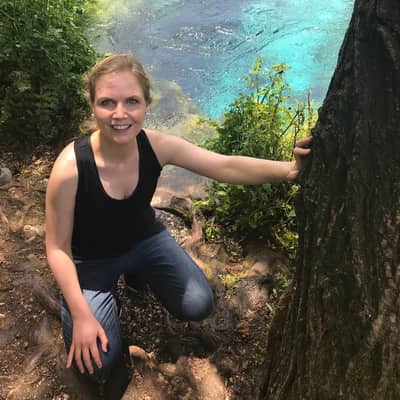
About me
I am an Albania Tour Guide, who organizes 1-day, 2-day or multiple day private tours in Albania. I arrange your transportation and I am your English speaking guide. So that, you get to experience the most beautiful places in Albania!
Kind regards, Manon

Welcome to Albania!
I am a Tour Guide in Albania
I am an Albania Tour Guide, who organizes 1-day, 2-day or multiple day private tours in Albania.
Book your free Albania Planning Session via Skype now, by using my online scheduler to find a time that’s convenient for you.
